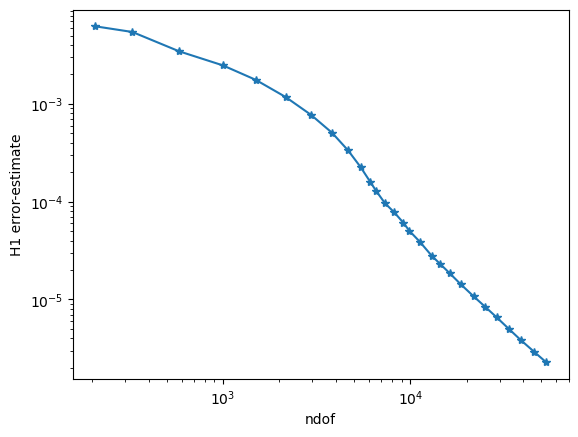This page was generated from wta/adaptivity.ipynb.
Adaptivity¶
[1]:
from ngsolve import *
from netgen.occ import *
from ngsolve.webgui import Draw
Define the geometry by 2D Netgen-OpenCascade modeling: Define rectangles and polygones, and glue them together to one shape object. OCC maintains the full geometry topology of vertices, edges, faces and solids.
[2]:
def MakeGeometry():
base = Rectangle(1, 0.6).Face()
chip = MoveTo(0.5,0.15).Line(0.15,0.15).Line(-0.15,0.15).Line(-0.15,-0.15).Close().Face()
top = MoveTo(0.2,0.6).Rectangle(0.6,0.2).Face()
base -= chip
base.faces.name="base"
chip.faces.name="chip"
chip.faces.col=(1,0,0)
top.faces.name="top"
geo = Glue([base,chip,top])
geo.edges.name="default"
geo.edges.Min(Y).name="bot"
Draw(geo)
return geo
geo = MakeGeometry()
Piece-wise constant coefficients in sub-domains:
[3]:
mesh = geo.GenerateMesh(maxh=0.2, dim=2)
print (mesh.GetMaterials())
('base', 'chip', 'top')
[4]:
fes = H1(mesh, order=3, dirichlet="bot", autoupdate=True)
u, v = fes.TnT()
lam = mesh.MaterialCF( { "base" : 1, "chip" : 1000, "top" : 20 } )
a = BilinearForm(lam*grad(u)*grad(v)*dx)
# heat-source in inner subdomain
f = LinearForm(1*v*dx(definedon="chip"))
c = preconditioners.MultiGrid(a, inverse="sparsecholesky")
gfu = GridFunction(fes)
Assemble and solve problem:
[5]:
def SolveBVP():
a.Assemble()
f.Assemble()
inv = CGSolver(a.mat, c.mat)
gfu.vec.data = inv * f.vec
SolveBVP()
Draw (gfu, mesh);
Gradient recovery error estimator: Interpolate finite element flux
\[q_h := I_h (\lambda \nabla u_h)\]
and take difference as element error indicator:
\[\eta_T := \tfrac{1}{\lambda} \| q_h - \lambda \nabla u_h \|_{L_2(T)}^2\]
[6]:
l = [] # l = list of estimated total error
space_flux = HDiv(mesh, order=2, autoupdate=True)
gf_flux = GridFunction(space_flux, "flux", autoupdate=True)
def CalcError():
flux = lam * grad(gfu) # the FEM-flux
gf_flux.Set(flux) # interpolate into H(div)
# compute estimator:
err = 1/lam*(flux-gf_flux)*(flux-gf_flux)
eta2 = Integrate(err, mesh, VOL, element_wise=True)
l.append ((fes.ndof, sqrt(sum(eta2))))
print("ndof =", fes.ndof, " toterr =", sqrt(sum(eta2)))
# mark for refinement:
maxerr = max(eta2)
# marking with Python loop:
# for el in mesh.Elements():
# mesh.SetRefinementFlag(el, eta2[el.nr] > 0.25*maxerr)
# marking using numpy vectorization:
mesh.ngmesh.Elements2D().NumPy()["refine"] = eta2.NumPy() > 0.25*maxerr
CalcError()
ndof = 208 toterr = 0.006210901700080993
Adaptive loop:
[7]:
level = 0
while fes.ndof < 50000:
mesh.Refine()
SolveBVP()
CalcError()
level = level+1
if level%5 == 0:
Draw (gfu)
ndof = 328 toterr = 0.005434323802496573
ndof = 583 toterr = 0.0034474161171851553
ndof = 997 toterr = 0.002477627265012537
ndof = 1492 toterr = 0.0017641880137192305
ndof = 2158 toterr = 0.0011758942564355933
ndof = 2950 toterr = 0.0007720685013193942
ndof = 3826 toterr = 0.0005050543888609116
ndof = 4651 toterr = 0.0003345739310087966
ndof = 5422 toterr = 0.00022627521650938286
ndof = 6121 toterr = 0.00015855832952392783
ndof = 6586 toterr = 0.00012787178850996432
ndof = 7321 toterr = 9.644005521438092e-05
ndof = 8200 toterr = 7.791024979144068e-05
ndof = 9184 toterr = 6.08270844371193e-05
ndof = 9895 toterr = 5.020406998257198e-05
ndof = 11209 toterr = 3.913525207513367e-05
ndof = 12994 toterr = 2.805369239514147e-05
ndof = 14365 toterr = 2.3273511701023858e-05
ndof = 16252 toterr = 1.848631827825046e-05
ndof = 18613 toterr = 1.4268464429447379e-05
ndof = 21763 toterr = 1.0776539402657111e-05
ndof = 25099 toterr = 8.414670493754942e-06
ndof = 28927 toterr = 6.561005754154133e-06
ndof = 33445 toterr = 5.037685791885999e-06
ndof = 38899 toterr = 3.844396993154618e-06
ndof = 45985 toterr = 2.9011699120564734e-06
ndof = 53179 toterr = 2.2778128477929746e-06
[8]:
Draw (gfu);
[9]:
%matplotlib inline
import matplotlib.pyplot as plt
plt.yscale('log')
plt.xscale('log')
plt.xlabel("ndof")
plt.ylabel("H1 error-estimate")
ndof,err = zip(*l)
plt.plot(ndof,err, "-*")
plt.ion()
plt.show();

[ ]: